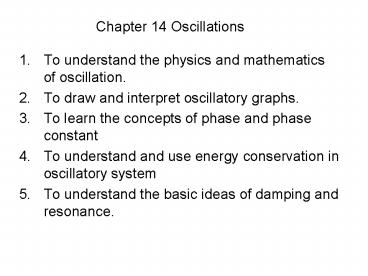Chapter 14 Oscillations PowerPoint PPT Presentation
1 / 19
Title: Chapter 14 Oscillations
1
Chapter 14 Oscillations
- To understand the physics and mathematics of
oscillation. - To draw and interpret oscillatory graphs.
- To learn the concepts of phase and phase constant
- To understand and use energy conservation in
oscillatory system - To understand the basic ideas of damping and
resonance.
2
Stop to think 14.1 page 414Stop to think
14.2 page 417Stop to think 14.3 page 419Stop to
think 14.4 page 423Stop to think 14.5 page 428
- Example 14.2 page 413
- Example 14.4 page 417
- Example 14.6 page 422
- Example 14.7 page 424
- Example 14.9 page 426
- Example 14.10 page 428
3
Simple Harmonic Motion
- Object or systems of objects that undergo
oscillatory motion are called oscillators. All
these oscillators have two things in common - 1. The oscillation takes place about an
equilibrium position, and - 2. The motion is periodic.
Sinusoidal oscillation Is called simple harmonic
motion.
4
Period and frequency
- Period T time per cycle, units second
- Frequency f the number of cycles per second.
units 1/s Hz (Hertz)
5
Graph of simple harmonic motion
- The amplitude A the maximum displacement from
equilibrium. - Measured A 0.17 cm
- Measured T 1.60s
- How to describe the displacement x using A, T,
and t.
6
Position vs time graph and velocity vs time graph
- Position-vs time graph Velocity vs
time graph
7
Angular frequency ?
We define ?2p/T 2pf, is called angular
frequency
V(max) ?A
8
Simple Harmonic Motion and Circular Motion.
- Uniform circular motion projected onto one
dimension is simple harmonic motion - The figure shows the x-component, when the
particle does uniform circular motion - With
- So
9
The Phase constant
- In more general case, particle start phase Fo is
not zero. then, - The harmonic motion function is
- Fo is called the phase constant or initial phase.
- is called
phase. - When t 0, initial condition
10
Show phase constant
- The following show the oscillations by different
phase constant
Notice Fop/3 and Fo-p/3 have the same starting
x, but different Vo
11
P14.2
- From the Figure, how we get
- Amplitude
- Frequency
- Phase constant.
- First, you write general Harmonic
- Wave function
- Then you compare this trigonometric
- Function and the figure, you can get
- A 10 cm
- T 2 s, frequency f ½ 0.5 Hz.
- When t 0 x(0) 5cm 10cos(Fo)
- cos(Fo)0.5, Fop/3.
- But at t 0, the slope of curve is negative
- So V0 is negative, from
- Sin(Fo) is positive, that makes Fop/3.
12
Energy in simple Harmonic Motion
- The mechanical energy of an object oscillating on
a spring is - When x A, E ½ kA2 0
- When x 0 E 0 1/2mV2 max
- From conservation of energy
13
The Dynamics of Simple Harmonic Motion
- The spring force is
- From Newtons second Law
- The dynamics equation
- This is second derivative equation, the solution
is
14
Vertical oscillations
- The equilibrium position, ?L.
- The harmonic oscillation equation should be the
same on a horizontal spring. - In right figure
- K 10N/m, The spring stretch at equilibrium
is given by ?Lmg / K 19.6 cm - That is the amplitude of oscillation
- A 30cm-19.6cm 10.4 cm
- The initial condition y0-A AcosFo
- Fop. So the oscillator function is
15
The Pendulum
- Lets look another oscillator a pendulum
16
Small-angle Approximation
- The Dynamical equation is
- Using
- We can write
- If ? is very small sin (?) ? (? in radians)
- Then
- Solution is
- Or
or
17
The Physical pendulum
18
Period vs Meff in log plot
19
V-10p sin(ptp/3)

